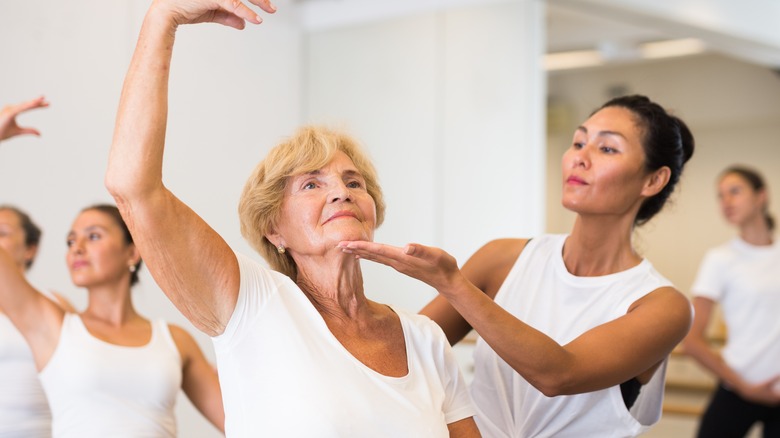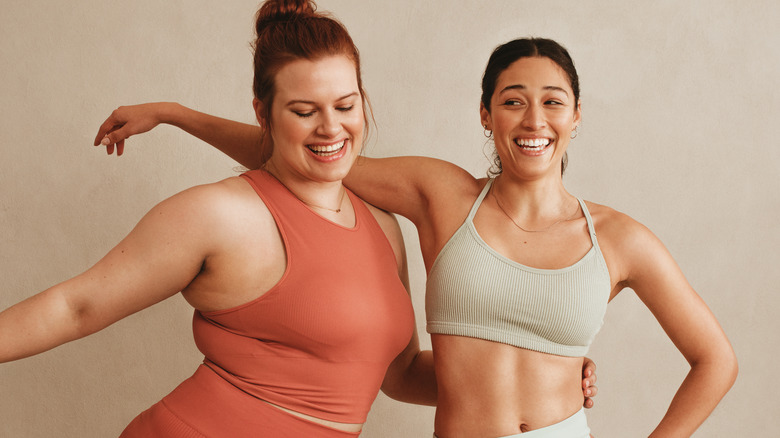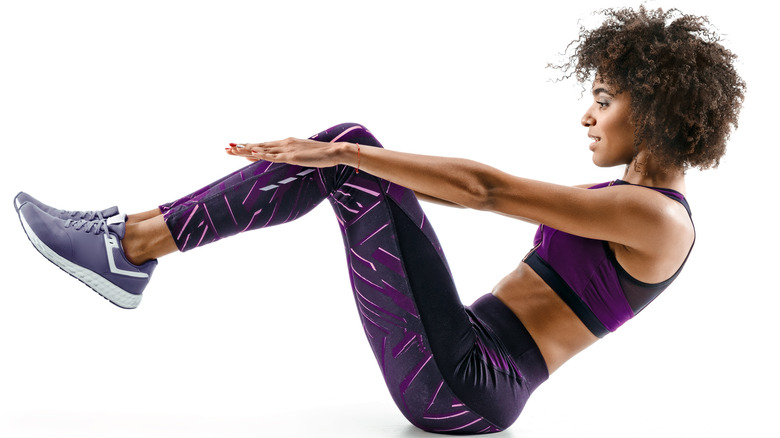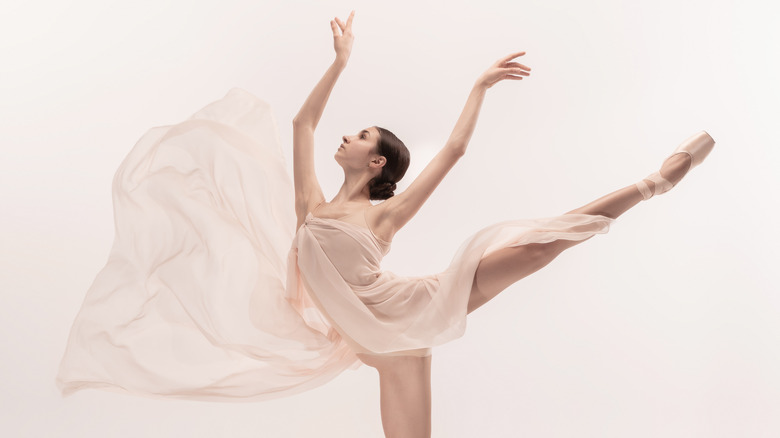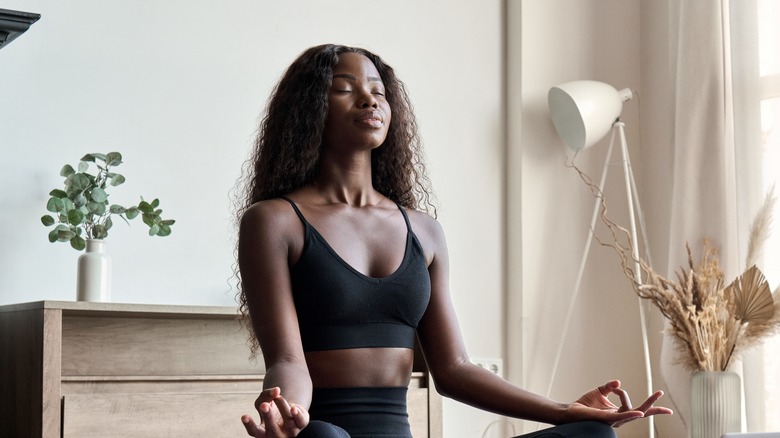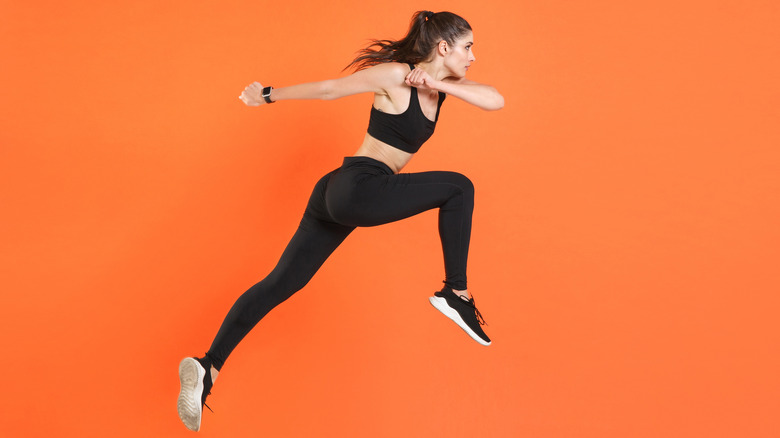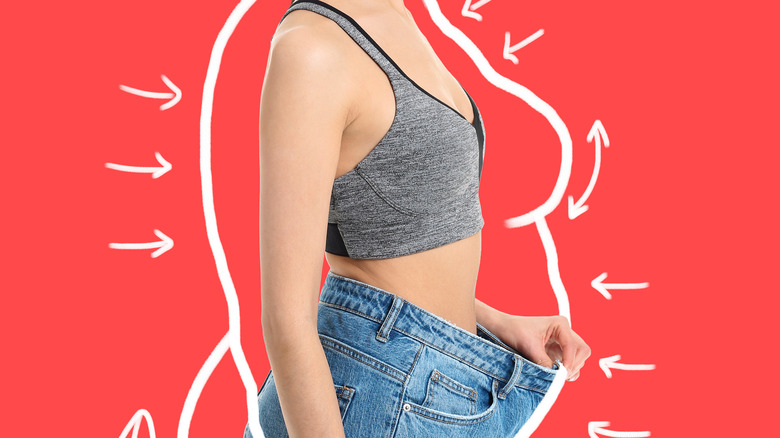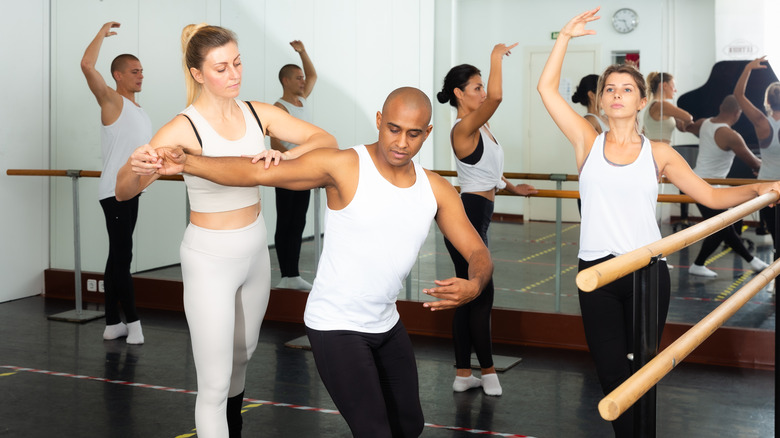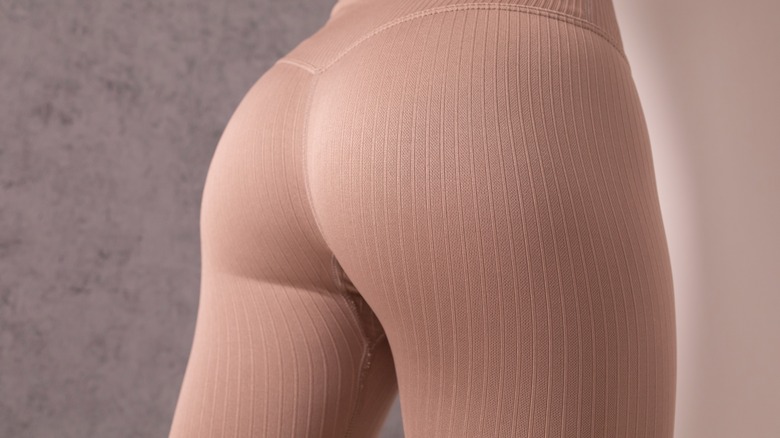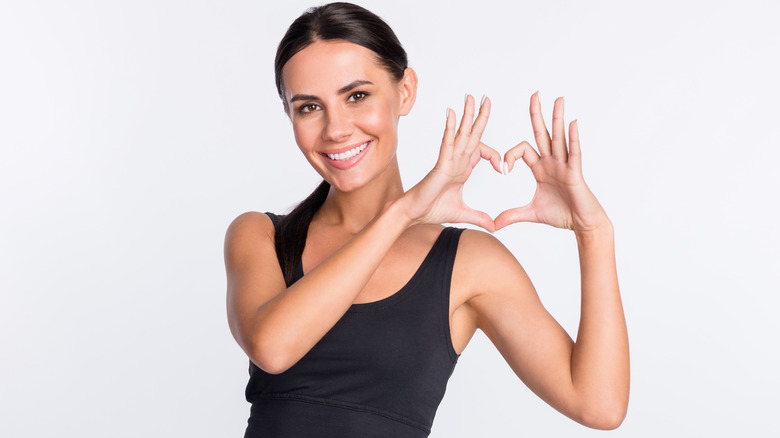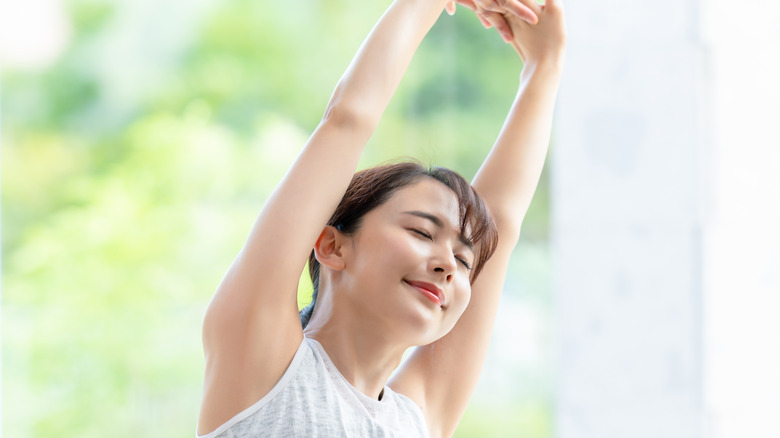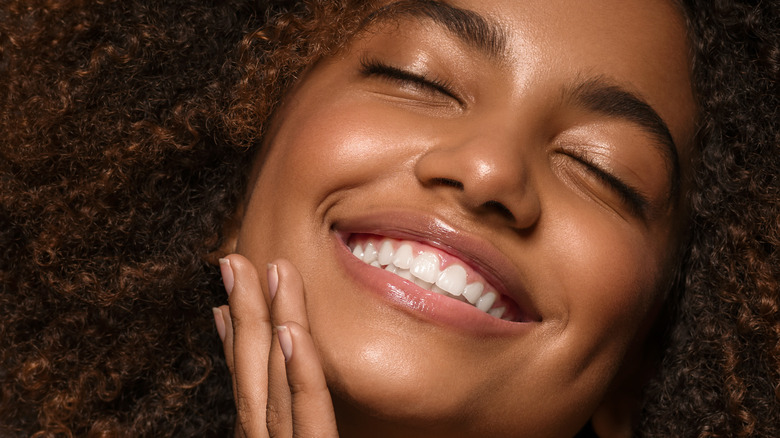When You Do Barre Workouts Every Day, This Is What Happens To You
You may have already heard of this workout before via the many celebrities who've sworn by it for creating "longer and leaner physiques." However, while celebrities may have popularized it in recent years, barre is actually a hybrid of some exercises whose roots extend back thousands of years.
According to WebMD, barre is essentially a modern-day hybridization of ballet, Pilates, and yoga that offers a combination of cardio, strength training, and muscle conditioning. Experts at the site explain that all of these elements work together to help you improve your flexibility, balance, and specifically help you work your abs, arms, glutes, and hips. One of the benefits of barre is that you don't have to be trained in ballet, yoga, or Pilates to give it a go. As a medium-intensity workout, classes are typically slower in place compared to more vigorous workouts. Suitable for those who are just beginning to work out, barre classes are low-impact and rely on what are called isometric contractions (per Self), which require you to use your own body weight as a form of resistance.
If you're curious about this workout and want to learn how it can affect your body, continue reading.
Your balance will improve
According to MindBodyGreen, barre classes are an excellent way to improve balance. Maintaining balance can help prevent us from falling and experiencing injuries, optimize our body's mobility, improve our agility, and maintain proper joint stability.
In a traditional ballet class, ballerinas would use the bar to stabilize themselves when practicing certain moves. They would start by using both hands on the bar to balance, moving on to one hand, and eventually stabilizing themselves in the middle of the floor without the bar. The bar is used in much the same way in a barre class, supporting students to build specific muscles that are used to balance.
Heel lifts, which are known as "releves" in ballet, can be practiced while holding onto the bar, contributing to overall balance. Another good balance exercise is the "attitude" exercise, where you face the bar holding it with both hands and lift your leg behind you with your knee bent, raising it up and down in small motions (and repeating it on the other side).
Your core will strengthen
Having toned ab muscles is a dream within reach if you commit to doing barre regularly. Bergen Wheeler, national director of Core Fusion talent development and senior teacher at Exhale Spa, spoke to Self about the benefits of barre on the ab muscles and explained, "Barre requires you to keep your core engaged at all times. So that means while you are working your arms, legs, and booty, your abs are working as well."
In some barre studios, instructors will tell their students to "brace" or "pull in," which helps them constantly engage their core muscles while they are working out. Aside from how great a toned belly may look, having strong abdominal muscles actually serves a practical purpose as well. Our core muscles contribute to our overall balance, stability, and posture.
Wheeler suggests incorporating exercises such as the plank push up into your routine to strengthen your core. In this exercise you begin in high plank, and place your feet on either a towel or two gliders. Without bending your knees, slide your feet inward using your abdominal muscles, bringing them toward your hands. Straighten them back out, and repeat.
Your flexibility will improve
Healthline explains that one of the primary side effects of consistent barre workouts is improving your flexibility due to the amount of stretching featured in the classes. MindBodyGreen seconds that notion, stating that the bar in barre classes is intended to assist you in stretching your muscles. However, if you happen to be working out at home, a chair or a countertop may suffice.
One stretch the site mentions works the quads, and requires the use of a resistance band or towel, and either a bar, chair, or countertop. To execute this workout, start by holding the bar with the right hand. Sling your left ankle in the band, and pull it up, bending at the knee. If you want a deeper stretch, the site suggests pressing your ankle more strongly into the band.
In case you were wondering how flexibility can support your daily life, another Healthline article reports that the benefits include having fewer injuries and improved physical performance. Additionally, developing more flexibility enables you to endure more physical stress, which can eventually lead to increases in physical performance as your muscles are able to work more effectively.
You'll improve your overall strength
If you're exercising with the intention of both looking better and feeling stronger, you're in luck when it comes to barre.
Byrdie consulted experts to get the scoop on the workout, and explained that one of the benefits of barre classes is that you don't have to lift heavy weights to see improvements in overall strength. Most classes only require small hand weights, resistance bands, or stability balls, and some classes don't even require you to use weights at all. Despite the fact you're not lifting heavy weights, the class is designed to work the full body — legs, arms, and core — all in one session. Verywell Fit dove into the topic a little bit more and explained that barre works muscles in ways they are not used everyday. For example, you may lower yourself into a squat, hold the position, and then stress the muscles a bit more by moving up and down, only to repeat it again.
Furthermore, as mentioned, barre classes rely on many isometric exercises, which Healthline defines as any type of exercise where you hold your body in one position. While you may not bulk up doing these types of workouts, they are designed to promote muscular strength.
Your anxiety may decrease
One pleasant and perhaps unexpected side effect of committing to a barre routine is that it may help decrease anxiety and stress.
In general, all forms of exercise have been proven to be effective in lowering anxiety, according to Harvard Health. A simple walk or a bike ride may be enough to reduce the effects of anxiety, so not to worry — your weekly barre class definitely makes the cut. So how does exercise affect the brain, exactly? Experts explain that the act of exercising quite simply diverts your attention away from whatever you may be stressing about and brings your focus to the present moment. Additionally, by moving your body, you are reducing muscle tension, which has been shown to contribute to feelings of anxiety. Moreover, exercise positively affects the part of our brain responsible for assessing "real or imagined threats to our survival," which can most definitely contribute to anxiety.
Also, remember the whole yoga component to barre? One of the many health benefits of yoga is its contribution to helping calm stress and anxiety, per the Mayo Clinic.
You'll gain muscular endurance
In addition to the changes you'll see in your overall strength, taking barre regularly can also help build muscular endurance. In case you're wondering what that means, Medical News Today defines muscular endurance as how long your muscles can take exercising. In other words, the more muscular endurance you have, the longer you'll be able to contract your muscles in the form of exercise, and the more repetitions you'll be able to do.
Verywell Fit confirms that barre classes are, in fact, effective at improving muscular endurance. Furthermore, a study published by the Journal of Strength & Conditioning Research followed 50 participants who took 12 weeks of Pilates classes, which contribute significantly to the makeup of barre classes. The study found that the participants who engaged in two 60-minute Pilates sessions a week saw significant improvements in "abdominal endurance, hamstring flexibility, and upper-body muscular endurance," and that low-intensity Pilates exercises represented an excellent way to improve muscular endurance with no equipment and little skill.
In the long run, muscular endurance can help you carry out daily activities, increase athletic performance, and improve the "aerobic capacity of muscles," among other things (per Medical News Today).
You may lose weight
On top of all these positive benefits, a svelte figure may be waiting for you if you decide to take up barre classes. While there are plenty of reasons to work out that don't have to do with losing weight, if you are looking to shed a few pounds, barre may be a good option.
Adrienne Richmond, a California-based Pure Barre owner, spoke to PopSugar and confirmed that the way barre workouts assist you in losing weight is by helping you break down muscle and increasing your strength via different exercises throughout the duration of the class. Richmond continues by explaining that barre class is designed to "work your muscle to fatigue," which means that your body has to "burn carbohydrates and break down fat stores" in order to rebuild your muscles.
However, barre classes may not be as effective as other forms of cardio when it comes to losing weight. Despite this, Pure Barre kinesiologist Rachelle Reed told Popsugar that barre is "important for both weight management and overall quality of life," and that "Any additional energy expenditure from exercise can help people to manage their weight more effectively." According to Reed, this type of workout can also give your metabolism a welcome boost that lasts until the end of your day.
Your posture may improve
Being told to sit up straight may take you straight back to your elementary school years and that one teacher who always seemed to have her eye on you. Aside from being a habit of a well-raised individual, having good posture can actually contribute a whole list of health benefits.
Healthline explains that good posture can help reduce lower back pain, lead to fewer headaches, increase your energy levels, and even increase your lung capacity. So how does barre help? According to Leah Willoughby, an instructor and founder of Wellness Pilates who spoke to Byrdie, "There's a big focus on strengthening the muscles through the chest and shoulders in barre practice, which in turn prevents us from slouching." The site further explains that because of the sense of elongation that you'll gain as a result, it may only take a couple classes for you to notice that you're already standing taller than you normally do.
Heather Carroll, a personal trainer who teaches both barre and ballet, spoke to Bustle and stated that taking barre classes on a consistent basis "can help to open up the chest so you can stay lifted through the front of your body while using the backside of your body for stability."
You will strengthen your glutes and thighs
If you want to tone and strengthen your rear and thighs, barre may be an effective workout. Self enlisted fitness experts and examined the benefits of barre on toning the glutes and thighs. The site explained that many of the movements that ballerinas do engage some of the more "elusive" muscles in the legs, including the inner and outer thigh muscles.
Dancer Jillian Dreusike, creator of Allongée Technique in Philadelphia, spoke to the publication and shared a series of barre workouts to specifically target the thighs and glutes. She also recommended that the exercises be repeated on both the left and right side, which can in turn help stabilize the body.
One of the first exercises is "Allongée Propellers," which you will do starting at the bar, or holding on to the back of a chair. Rest your hands on the back of the bar or chair, bending your right leg and bringing it all the way up to your chest. Keep your left heel lifted throughout. With your toes flexed, bend forward, lifting your right leg behind you toward the ceiling while your back remains flat. This exercise will work your glutes, thighs, and core, according to Dreusike.
Your heart health may improve
As you're probably very aware by now, physical activity is good for the body in numerous ways. In case you need confirmation from the experts, John Hopkins Medicine confirms that consistent exercise, combined with eating a healthy diet (such as the Mediterranean diet) and avoiding smoking, can help prevent coronary artery disease and vascular disease. Johns Hopkins expert Kerry Stewart, Ed.D. goes as far as to say that when it comes to certain cardiovascular illnesses, "exercise can be as powerful as some medications."
So how do exercises such as barre classes help your heart, exactly? For starters, exercise lowers blood pressure by working similarly to a "beta-blocker" medication: It slows down a person's heart rate and lowers their blood pressure, helping reduce the risk of heart disease. The winning combination of aerobic exercise and strength training also helps reduce the risk of heart disease.
Depending on your fitness level, aerobic exercise can include any activity that increases your heart rate, and strength training can include resistance training, both of which can occur during barre classes. This combination allows the muscles to draw in more oxygen from your blood, lessening the pressure on the heart to pump blood into the muscles itself.
Your range of motion may improve
While your range of motion may not be something you think about as you move throughout your day, it actually affects how easily you can perform many daily tasks.
Verywell Fit defines range of motion as the level of mobility one possesses with respect to a specific body part or joint. Think of stretching your arm to reach the cupboard — the higher you can lift your arm, the greater your range of motion is. Things that contribute to a limited range of motion include pain around the joints, muscle stiffness, and pain.
Another Verywell Fit article shared that in addition to improving muscular strength and flexibility, Pilates has actually been proven effective at increasing range of motion in the joints. Physical therapist Dr. Laeda Malek spoke to Verywell Health and explained the benefits of improving range of motion: "Improving range of motion allows for the muscles in question to work at longer lengths, which in turn allows you to build better strength and likely result in feelings of less tension. By having a stronger muscle that is capable of contracting efficiently through larger ranges of motion, you may be prone to less injury." By taking barre classes which incorporate Pilates moves, you can reap the positive side effects of this practice.
You may feel happier
Looking for a natural mood booster that can burn a few calories and tighten your glutes at the same time? Look no further than barre. As previously mentioned, exercise has some pretty positive benefits for anxiety and stress, and research has also linked it to a boost in mood as well.
Healthline reports that a cocktail of chemicals are released from your brain during exercise that can elevate your mood and leave you feeling high long after that barre class is over. Some of the more well-known chemicals in that cocktail are endorphins, which are recognized for their ability to block the body's ability to feel pain and heighten the experience of pleasure. Endocannabinoids are another chemical released during exercise that the site says may actually work together with endorphins to give you that euphoric feeling after working out. Dopamine is another neurotransmitter the brain releases that is also connected to the way we experience pleasure; however, more research is needed to determine which type of exercise best supports the release of this chemical.
Furthermore, exercise has also been shown to improve self-image and overall self esteem, and has been linked to a general boost in positivity.
Your mind-body connection may improve
As you can see, exercises such as barre create effects that go far beyond the physical. The connection between the mind and the body is not a new area of study, and Yoga Journal demystified the concept, explaining that whether we are aware of it or not, the mind-body connection is something that is constantly occurring as we go about our day. An example the site provides is that feeling of "butterflies" in your stomach you may experience right before a big speech, or your mouth watering at the mere thought of your favorite food.
Yoga — which again is a strong element featured in barre classes — is known for enhancing the mind-body connection with certain meditative techniques. These techniques can help unburden the mind, healing the stress response system and subsequently allowing the body to better heal itself. Michelle Ditto, Pure Barre Master Teacher Trainer, spoke to Verywell Fit and shed more light on the mind-body benefits of taking barre class. "Holding each position can be the most mentally challenging part of the class. Ultimately, a mental and physical connection is the goal of every class—how can you better attend to your body's cues and needs in a way that helps you go one inch deeper than you did yesterday."
Your energy levels may increase
If you're feeling fatigued, heading to barre class may feel like the last thing you want to do. However, it may be exactly what the doctor ordered to get your energy levels to where they need to be.
Similar to the effects that exercise can have on your mood, the same chemicals released during exercise that make you feel "high" can also boost your energy levels, according to fitness experts at Everyday Health. Dr. Robert Gotlin, a sports medicine specialist at Lenox Hill Hospital, spoke to the site and explained, "Endorphins are our body's natural hormones that get released when we are doing something that requires a burst of energy — they are the things that make us perform, make us move."
Another way physical movement increases energy levels is by improving cardiovascular health. Improved cardiovascular health is linked to greater endurance. When your endurance gets a boost, it becomes easier to complete daily tasks without depleting your energy. Furthermore, exercise is linked to getting a better night's sleep. If you sleep more at night, it makes sense that you'll have more energy during the day. In other words, don't let your fatigue be an excuse not to head to barre class. Grab your gear and head to class, because it'll pay off in the long run.

